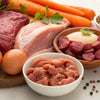How to Make Raw Dog Food Balanced: A Comprehensive Guide for Pet Owners
- Houndsy
Table of Contents
- Introduction
- Understanding Raw Dog Food Diets
- Key Components of a Balanced Raw Diet
- Common Nutritional Deficiencies in Raw Diets
- The Role of Variety
- How to Transition to a Raw Diet
- Conclusion
Introduction
Did you know that switching your dog to a raw diet can potentially increase their lifespan by up to 25%? This statistic certainly catches our attention as dog lovers who want nothing but the best for our furry companions. As pet parents, we often find ourselves weighing our options, striving to deliver the most nutritious meals that promote health, vitality, and longevity. With a surge in interest surrounding raw dog food diets, we felt compelled to delve deeper into how to make raw dog food balanced.
As we explore the topic, we'll help you understand the essential components necessary for a well-balanced diet, the importance of variety in protein sources, and the significance of nutrients that might be lacking in raw diets. By the end of this blog post, you'll not only grasp how to create a balanced raw food diet but also feel confident in implementing this holistic approach to your dog's nutrition.
Feeding our pets shouldn't be merely about convenience; it can also be an enriching experience that strengthens our bond with them. Let’s embark on this journey to provide our beloved pets with the healthiest, freshest, and most satisfying meals possible.
Understanding Raw Dog Food Diets
The Basics of Raw Feeding
A raw dog food diet focuses on providing dogs with fresh, uncooked ingredients that mimic their ancestral dietary patterns. This typically includes a blend of muscle meat, bones, organs, and sometimes, fruits and vegetables. Dogs, being evolutionary carnivores, thrive on nutrient-dense diets that are less processed than conventional kibble. To ensure optimal nutrition, the key lies in properly balancing the various components of the raw diet.
Types of Raw Dog Food Approaches
-
BARF (Biologically Appropriate Raw Food): The most popular method, known for its emphasis on providing a well-rounded, nutritious meal. A BARF diet often consists of:
- 70% lean muscle meat
- 10% raw meaty bones
- 5% liver
- 5% other secreting organs (like kidneys or hearts)
- 10% fruits and vegetables
-
Whole Prey Model: This approach aims to replicate the consumption of prey animals, primarily focusing on whole animals. The ratio typically follows:
- 80% muscle meat
- 10% raw bones
- 5% liver
- 5% other organs
-
RMBD (Raw Meat-Based Diet): This method emphasizes feeding primarily uncooked meat and may include organs and fully raw bones without as much focus on the inclusion of fruits and vegetables.
Nutritional Considerations
Each dog is unique, and their nutritional needs may differ based on age, weight, activity level, and health conditions. To prepare a well-balanced raw diet tailored to your specific dog, we’ll look at exactly which components are essential.
Key Components of a Balanced Raw Diet
1. Muscle Meat
Providing around 70-80% of your dog’s diet, muscle meat is rich in protein and essential amino acids that are crucial for growth, muscle development, and overall health. It’s essential to vary the protein sources to ensure a complete range of amino acids. Here are some beneficial meats to consider:
- Chicken: Rich in B vitamins and phosphorus.
- Turkey: A great source of protein and a lower fat option.
- Beef: Excellent for iron and B vitamins.
- Lamb: Provides essential fatty acids and zinc.
- Fish: Salmon and sardines are rich in omega-3 fatty acids, supporting skin health and immune function.
2. Organs
About 10-15% of your dog's diet should consist of organ meats, which are nutrient-dense and packed with vitamins and minerals. The focus should be on:
- Liver: Packed with vitamin A, B vitamins, and minerals.
- Kidneys and Heart: Offer a wealth of nutritional benefits, including CoEnzyme Q10 and taurine.
3. Bones
Raw meaty bones account for about 10-15% of the diet. They provide necessary calcium and phosphorous, crucial for bone health. Always avoid cooked bones as they splinter and pose choking hazards.
4. Fruits and Vegetables
Including roughly 5-10% plant matter is beneficial as it offers fiber, antioxidants, and additional vitamins. However, be aware that dogs lack the necessary enzymes to digest raw plant cell walls effectively. Therefore, consider pureeing or lightly steaming vegetables to enhance nutrient absorption. Great options for inclusion are:
- Carrots: Good for vision and dental health.
- Pumpkin: Excellent for digestive health.
- Blueberries: Packed with antioxidants.
5. Fats and Oils
Healthy fats are vital for energy, skin health, and metabolic function. Adding sources of omega-3, like fish oil or flaxseed oil, can also contribute to anti-inflammatory benefits.
Common Nutritional Deficiencies in Raw Diets
While raw diets can offer a range of health benefits, knowledge is crucial to avoid nutritional deficiencies. Here are some common nutrients that might be lacking:
- Calcium: Essential for bone health; ensure proper ratios of bone content.
- Vitamin D: Vital for calcium absorption; can be supplemented via fatty fish or cod liver oil.
- Zinc: Supports immune function; found in organ meats and seafood.
- Magnesium: Crucial for muscle and nerve function; leafy greens can contribute.
- B Vitamins: Including B12, important for metabolism and energy levels.
The Role of Variety
Feeding our dogs various proteins, organ sources, and plant ingredients promotes nutritional diversity. Regular rotation of proteins and ingredients helps prevent potential deficiencies and ensures well-rounded nutrition. Over time, the dog’s body can adapt to different proteins, and variety encourages a healthy gut microbiome.
How to Transition to a Raw Diet
Transitioning your dog to a raw diet should be done gradually to avoid digestive upset. Here are some steps to guide you through the process:
- Start Slow: Gradually introduce raw food over about a week, starting with 25% raw and 75% old food, then adjusting until it's fully raw.
- Observe: Keep an eye on your dog’s digestion, energy levels, and coat condition to gauge their adjustment.
- Adjust Portions: Understand your dog’s ideal calorie requirements, aiming for about 2-3% of their body weight in raw food daily.
- Consult a Vet: For specific health concerns or if uncertain, always consult with a vet or a canine nutritionist to tailor the diet based on your dog’s needs.
Conclusion
In conclusion, crafting a balanced raw diet for our dogs involves a thoughtful approach that comprises proper protein sources, nutrients, and attention to variety. As we adopt this more holistic perspective towards pet care, we feel empowered by the opportunity to cultivate better health and happiness for our furry family members.
We've explored how to make raw dog food balanced and how you can elevate your dog's nutrition—now it's our turn to take action! If you're ready to simplify and enhance the daily feeding experience with a thoughtful solution, consider exploring the Houndsy Kibble Dispenser for a blend of convenience and design excellence, ensuring your dog enjoys every meal to the fullest.
FAQ
How do I determine the right balance of ingredients for my dog's raw diet?
The typical guidelines suggest about 70-80% muscle meat, 10-15% organs, and 10% bone, with or without integrating about 5-10% fruits and vegetables. However, individual needs may vary, so consulting a vet can provide clarity.
Can dogs digest raw plant matter effectively?
Dogs require some preparation to absorb nutrients from plants, such as pureeing or lightly steaming vegetables to break down their cell walls, making nutrients more bioavailable.
What if my dog has picky eating habits?
Incorporating a gradual transition, mixing appealing flavors, and trying various protein sources could help appeal to picky eaters. Rotating ingredients also keeps meals interesting.
Is it safe to feed raw bones to my dog?
Raw bones can be safe; however, they should always be raw, as cooked bones can splinter. Consider sizes that are appropriate for your dog's breed.
Where can I find raw ingredients for my dog's diet?
Many local butchers, farmers' markets, and specialty pet food stores carry raw meats, while online options provide easy access to various sources of raw ingredients tailored for pets.












